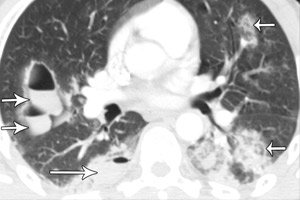
All iLive content is medically reviewed or fact checked to ensure as much factual accuracy as possible.
We have strict sourcing guidelines and only link to reputable media sites, academic research institutions and, whenever possible, medically peer reviewed studies. Note that the numbers in parentheses ([1], [2], etc.) are clickable links to these studies.
If you feel that any of our content is inaccurate, out-of-date, or otherwise questionable, please select it and press Ctrl + Enter.
Hematocele of the lung
Medical expert of the article
Last reviewed: 04.07.2025

In case of traumatic damage to the lung tissue with preserved integrity of the visceral pleura, a hematocele of the lung may occur. This pathology is accompanied by chest pain, difficulty breathing, and sometimes hemoptysis.
Causes hematoceles of the lung
Lungs are damaged due to mechanical impact on the chest area. This can be a blunt blow or the impact of a blast wave on the chest area. Most often, the injury is the result of a traffic accident, when the driver gets a chest bruise on the steering wheel.
Pathogenesis
During a strong blow to the chest area, its supporting framework is damaged: the ribs bend, damaging the lung tissue, injuring the vascular network. As a result, the lung parenchyma leaks blood. Against the background of increasing intrathoracic pressure, the interalveolar septa rupture, cyst-like elements are formed, which are filled with blood: this is a hematocele. Due to the counter-impact force, similar elements appear on the other side. The areas of the lungs soaked in blood become less elastic, which negatively affects gas exchange and entails increasing oxygen starvation. [ 1 ]
Symptoms hematoceles of the lung
The clinical picture of the pathology may vary, depending on the extent of the damage. In relatively mild cases, patients report only slight pain in the chest, on the affected side. The pain tends to intensify during deep inhalation and body movements. [ 2 ]
If there is a symptom such as hemoptysis, this indicates moderate or severe damage. Among other specific signs, the following can be distinguished:
- increasing difficulty breathing;
- increased heart rate;
- hypotension;
- pallor and even cyanosis of the skin;
- external hematomas and bruises.
Complications and consequences
Limited superficial hematocele of the lung may proceed without any particular consequences. Moderate and severe pathology may be complicated by post-traumatic pneumonia, formation of pneumofibrous zones. [ 3 ]
Who to contact?
Prevention
Prevention of complications involves the patient seeking medical attention in a timely manner and following the doctor’s recommendations.

